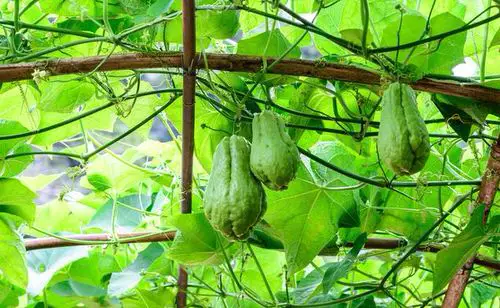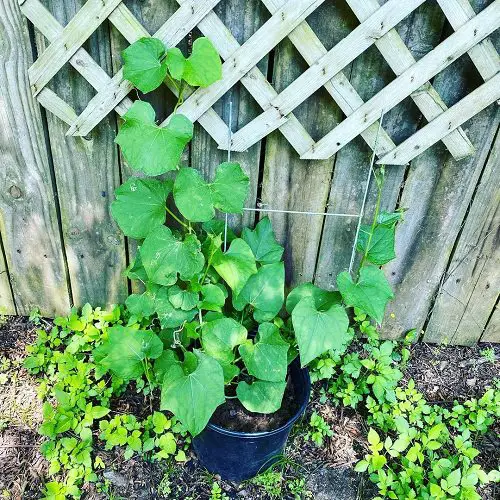Do you know about a pear-shaped, light green-colored fruit called Vegetable Pear? If not, then learn all about Growing Chayote in Pots!

Chayote is a tender perennial and produces white fruits with a nutty flavor. This vigorous vegetable grows best in warmer, subtropical, or tropical regions. Follow the article to learn about Growing Chayote in Pots!
Botanical Name: Sechium edule
Common Names: Chayote, Madeira marrow, Vegetable pear, Guadeloupe, Bermuda, Trinidad, Tobago, Nicaragua, Cidrayota, Gayota, Huisquil, Güisquil, Chocho, Chuchu, Xuxu, Machiche, Machuchu, Christophine, Mirliton
Learn how to grow broccoli easily in pots here
Is Chayote a Fruit or a Vegetable?
Chayote is technically a fruit but people consume it like a vegetable. Its seeds, flowers, and skin–all are edible. It has a crisp taste when raw, and becomes soft and mild when it is cooked. When eaten raw, it resembles the taste of a cucumber.
Growing Chayote in Pots
It is recommended to use fresh chayote instead of using the seeds. You could buy them during the fall. Keep them in the dark and cool places such as the garage or a cupboard. This process helps the seeds in the fruits to sprout better.
The plant is a warm-season, tender perennial. It will perform best in hot tropical or subtropical regions.
- Plant the Chayote in a deep container by scooping out a hole in the center to make space for the fruit and bury it 4-6 inches deep. Do it in spring, before the last average frost date in your area.
- Use an evenly moist soil mix that contains an equal portion of perlite, peat moss, and vermiculite. You can also opt to use a moistened potting soil mix. It does best in the Ph range of 6.0 to 6.8.
- Place the pot in a spot that receives full sunlight. If you choose to put it indoors, it needs to be placed in an area about 1-2 feet from a west, south-facing window with plenty of sunlight.
- Water the plant only whenever the soil starts to feel dry. These plants need a regular watering routine but also make sure that you are not overwatering the plant and making the soil soggy.
- The best pot size for growing chayote is 16-18 inches.
Support

Provide the help of a trellis in the pot once the plant grows a bit tall as it is a climber, and support is crucial for the plant’s health and fruit production. It is important to take good care of the vines as they grow up to 30-35 feet long before fruiting from September to October or bloom from August to September.
Additional Tip: Place the container on a bed of damp marbles to raise the humidity for the tropical plant if needed.
Fertilizing Chayote
Use a balanced liquid fertilizer once in 2-3 weeks. Also, side-dressing every 4-6 weeks during the growing season and using aged manure during the midseason will help to boost the plant’s growth and will aid in fruiting.
Pests and Diseases

It is a huge relief that this tropical plant does not have any severe issues. However, aphids or whiteflies may attack the plant. Either handpick them or use a strong jet of water to throw them off. Thankfully, the plant is not susceptible to diseases.
Care in Cold Weather
In cold-winter regions, use 3-5 inches thick mulch before the first frost during the winters. This vegetable requires a minimum of 110-140 frost-free days to harvest. If you live in a colder region with shorter summer months, it is wise to grow the plant in a container and bring it indoors when the temperature drops.
Harvesting and Storing Chayote
Once the fruits grow up to 4-6 inches in diameter, you would know it is time to harvest. Use a sharp knife to cut the chayote from the vine and do it before the fruit flesh starts to harden. If the flesh sets, the taste, and the texture gets affected too.
You can store the fruits in the refrigerator for up to 7-10 days or deep freeze diced chayote for 10-12 months.
Chayote Uses

- Most commonly used for its edible fruits, the stems are also used to make hats and baskets.
- You can also add it to beef, bacon, and vegetables.
- Stuff cheeses between chayote slices and fry them to create a side dish.
- Cook chayote with broth, onion, butter to make a delicious soup.
- Chicken Tinola, a popular Filipino dish, tastes best with chayote, chicken legs, and vegetables in broth.
- The growing leaves have also been infused as tea.
- You can also slice it like an apple and fry it in butter with cinnamon and sugar.



Chayote is very difficult to get to fruit when planted in a container because they are sensitive to fluctuations in soil moisture. We have only had luck using large 30-50 gallon containers. Also, you need to buy chayote that were grown in your area rather than imported chayote that grocery stores sell.